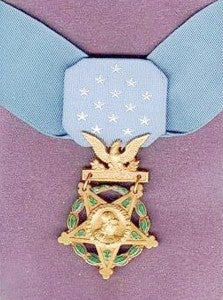The Medal of Honor, going beyond the call of duty
Published 10:28 am Thursday, July 26, 2012
Most of our civilian population probably has little appreciation for the Medal of Honor because they probably do not know much about it.
There is not room here for me to tell you even half of what I would like you to know about it, so I’d better get started without further ado:
One of the first things a new recruit into the Army (the Air Force was still in Army uniforms when I enlisted in 1948) learns is how to salute officers. Next we were shown a large picture of the Medal of Honor and the small piece of its neck ribbon that is worn at the top of one’s ribbons above the left pocket. Why? Because everyone renders the salute to the holder of that medal; even commissioned officers must salute an enlisted man wearing the ribbon!
The Medal of Honor is approved by the Congress and awarded by the president of the United States. That should tell you that it is not given lightly and is earned by heroic action far beyond the call of duty. There have been few living recipients; about half of the medals are awarded posthumously, as was that of Polk County’s only recipient, PFC Bryant H. Womack.
Womack’s family moved to Rutherford County while he was serving in Korea. His portrait has hung in a place of honor in the Rutherford County Courthouse for all the years since the Korean War. The Army named a bridge in Korea for him, and two large hospitals, one in Germany and one at Fort Bragg, N.C. Polk County did nothing to honor his memory until at my urging county commissioner Alan Peoples proposed naming the new justice building for Womack. How many more years did it take for us to add his portrait to the building?
Howard Greene was Bryant Womack’s Army mentor and advised him not to become a medic, for he would find himself in the thick of combat with no weapon to defend himself. Womack probably could have avoided service entirely as a conscientious objector, but chose to serve as a medical corpsman because he said he did “not want to kill anybody.” Howard was probably the last person from Polk County to see Bryant alive; he used to give young Womack rides home from Fort Jackson, near Columbia, S.C.
One day Howard and I were riding around the county planning a route for one of the historical association’s tours. He suggested that we stop in to see George Womack, Bryant’s brother, and we found him at home. While standing in his study, I noticed several photographs on his desk. Several were of Bryant, so I asked if I could have them copied for the association. “Yes, if you make some for me,” George agreed.
Chris Bartol did the honors, and I framed a set for the Association, gave the county manager a set for the Womack Building, and returned some to George. Later, when I did not see the pictures in the building, I asked about them and they could not find them. There was some talk of naming the new high school for Bryant (we would then have the alliterative Womack Wolverines!) but as yet nothing has come of that. I mention all of this only to support my lament above that civilians have little appreciation for the Medal of Honor.
The late Joe Foss was flying to a speaking engagement shortly after 911 and had his Medal of Honor in his pants pocket. The ignorant security people took it away from him because he could hurt somebody with it! I don’t know how that was resolved, but I hope you will learn what the medal looks like and understand that it is earned (not won) by some pretty special people to whom we all owe a debt of gratitude.






